Let’s do a little test. Get up, and head over to wherever you keep your T-shirts — anything that’s cotton, really. Long sleeve, short sleeved, tank tops.
Look at the bottom, a few inches above the hem. I’m willing to bet that there’s at least two or more itty-bitty holes right there, as if a moth decided to go rogue and ditch the all-wool diet. Teeny-tiny pinprick holes that tend to get ever-so-much larger with each wearing. A star map of holes dancing above your navel area.
I’m upset about these mysterious, maddening, vexingly pervasive non-moth holes. A few years ago, I went down a Google-hole to figure out the cause, and quickly discovered the answer, which feels both obvious and impossible. Friction. The fronts of my shirts are rubbing against my pants button, my belt buckle, the front of counters — and little holes are springing up as a result.
But my pants are hardly sharp-edged or soaked in starch. The edges of my counter are not serrated. I don’t have some sort of razor-edged belly button. How can every.single.cotton shirt I own — across all price points, from the $10 ones from Old Navy that I don’t really expect to last that long, to the “nicer” ones from Splendid or James Perse (in the $40 to 75 range) and even that crazy-spendy one I got suckered into from Rag & Bone, which was close to $100 ) — how can they sprout little sprinkler holes within a few wearings?
The fronts of my shirts are rubbing against my pants button, my belt buckle, the front of counters — and little holes are springing up as a result.
I dug through my husband’s drawers to see if his T-shirts were suffering in the same way and boom: hole city. A few times, when I caught the problem in time — looking at you, enormous cache of striped “Breton” Boden shirts, retail price $38 each — I contacted that brand and complained, and they kindly sent me new ones since I had gotten in touch within their guarantee window. They sprouted new holes eventually,too.
But don��t take it from me. You can head to the Facebook page called “Holes in the front of my shirts!!” that is operated by Karen Wilkinson, a stay-at-home mother in California. The page, which has 1,300 followers, is a place where she uploads pics of her latest bedraggled tees and urges others to do the same. “At first I thought it was caused by being splashed by liquids which contain an enzymatic,” Wilkinson told me of her hole problem. “But after a couple of years, and lots of comments on the FB page, I started to realize it was just rubbing when wearing jeans and belts, especially when rubbing up against hard surfaces i.e. in the kitchen.”
Commenters are equally, earnestly, enraged, especially when other people don’t seem to feel the same aggravation. Wrote one: “It’s a very serious and frustrating issue and we need to get to the bottom of it.” Another suggested this bulky work-around: a patch of masking tape on the inside of her shirts, as a protective barrier. One woman wondered: “Are they portals?”
The thing that really gnawed at Wilkinson was why this was happening now.
“I don't remember experiencing this years ago. It seems to be a recent thing within the last 10 to 15 years only. I started to study cotton production. I contacted cotton companies and cotton guilds,” she said. “What I learned was that the vast majority of cotton for the clothing industry, especially the fine, slubby tee shirts we love, comes from China. And, the Chinese pick their cotton three to four times a year as opposed to premium cotton which is harvested only once or twice. The more harvests the cotton plant has, the shorter and weaker the cotton fibers become. By the last pick the fibers are very short indeed.”
Of course, it’s hard to fact-check all of this, Wilkinson said. I admire her honesty, not to mention the depth of her research: “It goes way beyond my capabilities of investigation right now, but I have spent a considerable amount of time writing to various companies over the years.”
She’s thrilled that I’m writing about this, by the way. “All this waste is totally senseless, and immoral, actually! I've lost countless T-shirts over the years to this — in fact every single one,” she said. “The only T-shirt I have now that has not been affected is one which has gold thread running through it, and the metal obviously offers some resistance. “
To get a legit “expert” take on this hole epidemic, I asked Carolyn Forté, the director textiles at the Good Housekeeping Institute, to weigh in. She said it’s pretty much just how cotton behaves in the wild. “Anything that abrades against the fabric can, over time, wear through to form a hole, especially if the fabric is thin to begin with,” Forté told me. Location is the first determinant. “The center front of a T-shirt is also the area of the shirt most exposed to wear and tear,” she said. “We pull it down when it rides up, carry and hold things against it, get stains on it, and more.”
One woman wondered: “Are they portals?”
The second issue is just the knit factor: cotton is generally more susceptible to holes than tightly woven fabrics are. And cotton knits — which is typically what T-shirts are, as they involve jillions of threads of cotton — are stretchy, open and have more places for things to snag and get caught on, according to Forté. “And the quality of the fibers and fabric matters, too. Knits made with combed and long staple cotton fibers are higher quality and mean that the yarns are stronger and less susceptible to breakage than yarns made with lower quality cotton fibers,” she said. “And thicker, heavier, more tightly knit fabrics will generally be more durable, too. When shopping, put your hand under the fabric and hold it up to the light. If you can clearly see your hand, chances are the fabric is thin and may not wear as well.”
Finally, washing and drying is abrasive, too, Forté said. “Weak spots can turn into holes in the washer or dryer when the shirts are tumbled, twisted and rub up against other items in the load.” (For the record, I’m washing on the gentle cycle or doing it by hand. I’m hanging them to dry. My clothes are treated more tenderly than my kids.)
Apparently, there are also people out there looking to solve this woe, as well as make a buck off of button-shirt friction. For $8 (free shipping!) I can get a “Shirt Guardian,” a little rubber cover for my buttons that somehow promises to eliminate the problem.
But what about other measures? Seems to me what we really need is some fabric reinforcement where it counts — and not a patch of sticky tape. I can buy pants for my kids with extra durable fabric at the knees; why can’t they make reinforced, invisible panels at the front lower half of tee shirts for women? Or, failing that, an iron-on patch which you can place at the inside of the T-shirt to reinforce the lower front panel, Wilkinson suggested.
When it comes to this issue, I feel somewhat like the proverbial old man, yelling at the kids to get off his lawn, to no avail. So perhaps I should just let it go, or at least more deeply consider what that woman said: perhaps they are portals of some kind. Messengers from another realm. I’ve got my ear to the openings. I am listening.
Are you upset about something and want to write about it? Email leah@theoutline.com.




